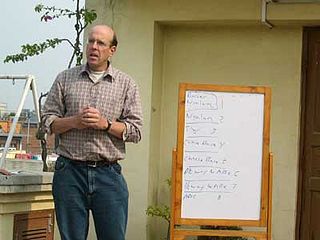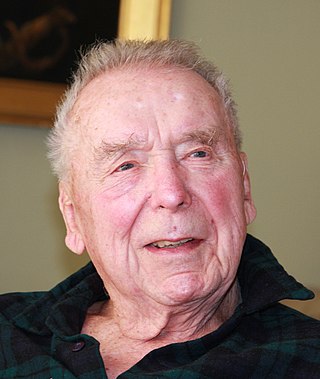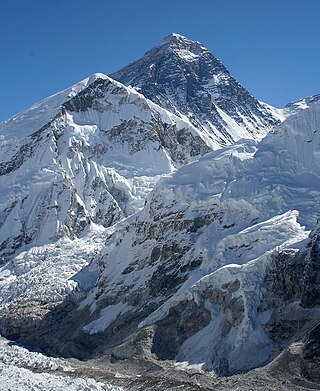
Mount Everest is Earth's highest mountain above sea level, located in the Mahalangur Himal sub-range of the Himalayas. The China–Nepal border runs across its summit point. Its elevation of 8,848.86 m was most recently established in 2020 by the Chinese and Nepali authorities.

In mountaineering, the death zone refers to altitudes above a certain point where the pressure of oxygen is insufficient to sustain human life for an extended time span. This point is generally tagged as 8,000 m (26,000 ft), where atmospheric pressure is less than 356 millibars. The concept was conceived in 1953 by Edouard Wyss-Dunant, a Swiss doctor, who called it the lethal zone. All 14 peaks above 8000 m in the death zone are located in the Himalaya and Karakoram regions of Asia.

Edmund Viesturs is an American high-altitude mountaineer, corporate speaker, and well known author in the mountain climbing community. He was the first American climber to ascend all 14 of the eight-thousander mountains, and the 5th person to do so without supplemental oxygen. Along with Apa Sherpa, he has summitted eight-thousanders on 21 occasions, including Mount Everest seven times.

Mera Peak is a mountain in the Mahalangur section, Barun sub-section of the Himalaya and administratively in Nepal's Sagarmatha Zone, Sankhuwasabha. At 6,476 metres (21,247 ft) it is classified as a trekking peak. It contains three main summits: Mera North, 6,476 metres (21,247 ft); Mera Central, 6,461 metres (21,198 ft); and Mera South, 6,065 metres (19,898 ft), as well as a smaller "trekking summit", visible as a distinct summit from the south but not marked on most maps of the region.

David Sharp was an English mountaineer who died near the summit of Mount Everest. His death caused controversy and debate because he was passed by a number of other climbers heading to and returning from the summit as he was dying, although a number of others tried to help him.

Daniel Lee Mazur is a mountain climber, expedition leader, and philanthropist who has ascended nine of the world's highest summits, including Mount Everest and K2. In addition, he is known for several high altitude mountain rescues: the 1991 rescue of Roman Giutashvili from Mount Everest, the rescue of Gary Ball from K2 in 1992, the rescue in 2006 of Australian climber Lincoln Hall from Mount Everest, and the rescue of British mountaineer Rick Allen from Broad Peak in 2018.

Seaborn Beck Weathers is an American pathologist from Texas. He survived the 1996 Mount Everest disaster, which was covered in Jon Krakauer's book Into Thin Air (1997), its film adaptation Into Thin Air: Death on Everest (1997), and the films Everest (1998) and Everest (2015). His autobiographical book, titled Left for Dead: My Journey Home from Everest (2000) includes his ordeal, but also describes his life before and afterward, as he focused on saving his damaged relationships.

Charles Snead Houston was an American physician, mountaineer, high-altitude investigator, inventor, author, film-maker, and former Peace Corps administrator. He made two important and celebrated attempts to climb the mountain K2 in the Karakoram Range.

The 1996 Mount Everest disaster occurred on 10–11 May 1996 when eight climbers caught in a blizzard died on Mount Everest while attempting to descend from the summit. Over the entire season, 12 people died trying to reach the summit, making it the deadliest season on Mount Everest at the time and the third deadliest after the 23 fatalities resulting from avalanches caused by the April 2015 Nepal earthquake and the 16 fatalities of the 2014 Mount Everest avalanche. The 1996 disaster received widespread publicity and raised questions about the commercialization of Everest.

The 2006 Philippine Mount Everest expedition is a Filipino mountaineering expedition that made a successful attempt to reach the summit of Mount Everest via the traditional southeast ridge route in May 2006 during the spring climbing season in the Himalayas. It was the first national expedition organized by the Philippines to reach the summit of world's highest mountain.

Pat Falvey is an Irish high-altitude mountaineer, expedition leader, polar explorer, entrepreneur, author, corporate/personal trainer/coach, and motivational speaker. He was the first person to complete the Seven Summits (Bass) twice, with the summiting of Mount Everest reached from both the Tibetan (1996) and Nepalese sides (2004). He was expedition leader of the team that saw Clare O'Leary become the first Irish woman to reach the summit of Mount Everest (2004). Other extreme expeditions that he has made include walking to the South Pole, crossing South Georgia Island, and traversing the Greenland ice cap. He started his first business at 15 years of age and has since had businesses in property development, finance, construction, insurance, tourism, and film production. He has been a motivational speaker since the 1990s.

Wilderness medicine is a medical specialty concerned with medical care in remote, wilderness and expedition environments. The specialty includes prior planning, public health issues, a number of sub-specialties as well as responding to emergencies. One modern definition of wilderness medicine is "medical care delivered in those areas where fixed or transient geographic challenges reduce the availability of, or alter requirements for, medical or patient movement resources".
Lewis Griffith Cresswell Evans Pugh, generally known as Griffith Pugh, was a British physiologist and mountaineer. He was the expedition physiologist on the 1953 British expedition that made the first ascent of Mount Everest, and a researcher into the effects of cold and altitude on human physiology.

Mirza Ali Baig is a Pakistani mountaineer and the first Pakistani man to summit all seven highest peaks in seven continents. Also, Mirza is a professional tourism expert, he is the pioneer who introduced extreme sports to women in Pakistan and made several documentaries related to the extreme adventure in Pakistan particularly women in mountaineering and outdoor.
Michael Phelps Ward, CBE was an English surgeon and an expedition doctor on the 1953 first ascent of Mount Everest with Sir Edmund Hillary. He argued that the conquest of the mountain was a victory for science since doctors had finally figured out how to cope with the physiological effects of high altitude. His discoveries a few years earlier in the Royal Geographical Society archives of the Milne-Hink map and unofficial RAF photos of the Everest area helped to make the summit ascent possible.

Mount Everest in 2016 covers events about Mount Everest, the highest mountain on Earth located in Nepal and Chinese Tibet in Asia. It is a popular climbing destination for extreme high altitude climbers, with several hundred climbing each year despite various dangers.
The 1960–61 Silver Hut expedition, formally known as the Himalayan Scientific and Mountaineering Expedition, was initiated by Edmund Hillary and Griffith Pugh with John Dienhart of World Books in America. The expedition lasted from September 1960 to June 1961.
Peter H. Hackett is an American mountaineer and medical doctor. He is the third person to have summited Mount Everest in a solo ascent, climbing from South Col to the top on October 24, 1981. He studies the effect of altitude on human physiology, and is the founder of a medical rescue camp on Everest and a rescue clinic and lab on Mount Denali, and the director of the Institute for Altitude Medicine in Colorado.













